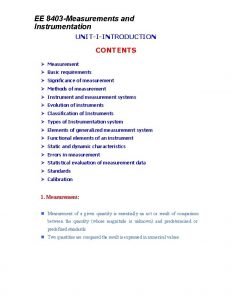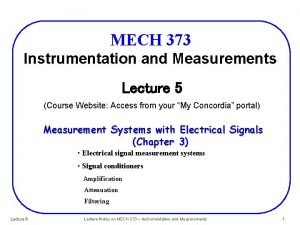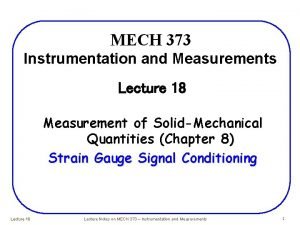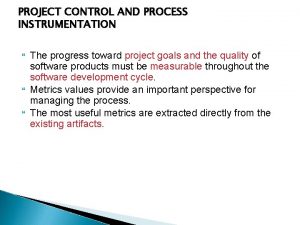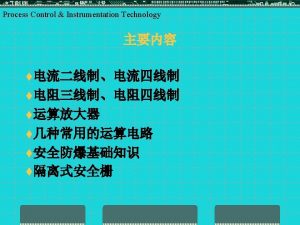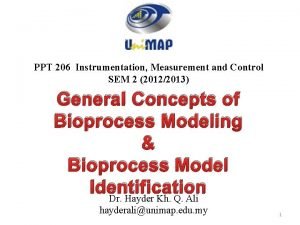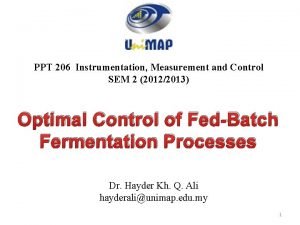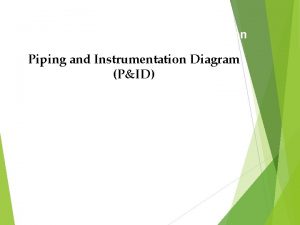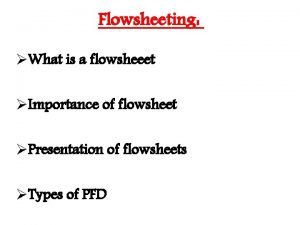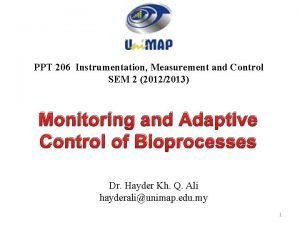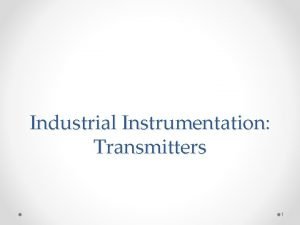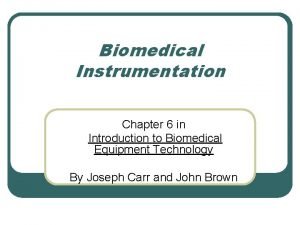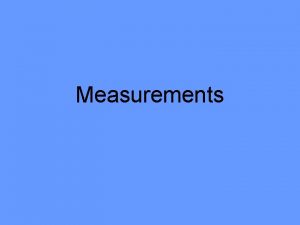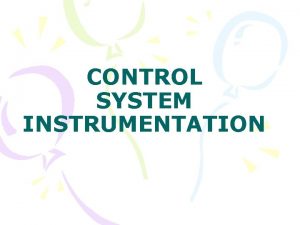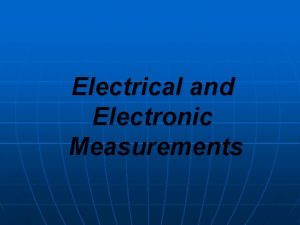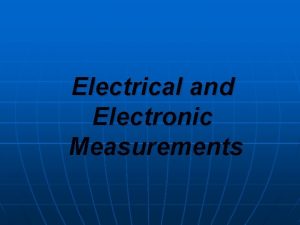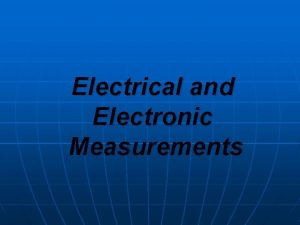Instrumentation and Process control Qualities of Measurements Definition















- Slides: 15

Instrumentation and Process control

Qualities of Measurements Definition : Ø Measurement means quantification of a parameter Ø A measuring devise or instrument is a devise that determines the value of a quantity or condition Measuring parameters: 1. Temperature 2. Pressure 3. Flow rate 4. Level 5. Composition

�The main objective of the process instrumentation is to obtain a numerical value of corresponding measured variable. So that the quality of product is measured & efficiency of production can be enhanced. � 1. Why is the measurement being made � 2. What should the measurement mean � 3. What measurement is made � 4. What is the result of making this measurement

Applications of measurement systems 1. Monitoring process & operations : Measures and displays the quantity or condition Ex: Thermometer 2. Control of Process & operations: Measures the desired parameter and controls the operation Ex: AC 3. Experimental Engineering Analysis: Characterization, raw data to analysis

Direct & Indirect measurements �Direct measurement: Direct measurement is measurement made directly of a parameter with an accepted standard. Ex: Measuring dimensions of a piece or wooden block �Indirect measurement: We measure a parameter by measuring another parameter which is more convenient to measure Ex: 1. Concentration of liquids (absorbance) 2. Acidity (Litmus Paper) 3. Temperature of milk (Bactria count)

The functions of instruments �A measuring instrument is a devise for determining the value of a quality of condition. Functions: � 1. Transmitting: Instrument conveys information concerning the measured quality over some distance to remote point. Ex: Telephone � 2. Signaling: Instrument indicates the general value or range of values of its measured quantity. Ex: Grocer’s scale

� 3. Registering: Instrument merely indicates by numbers or some other symbols of discrete increments, the value of some quantity. Ex: Water meter and Counting Machine � 4. Indicating: Instrument indicates the value of the measured quantity using a calibrated pointer and scale. Ex: Pressure gauge and Rotameter � 5. Recording: Instrument keeps a written record of the measured quantity usually against time. Ex: Data logger (Temperature)

�An instrument is cascade of several elements. The elements perform prescribed functions in converting a quantity into a corresponding indication. �The process of conversion in an instrument is necessary in order to change the measured variable, temperature, pressure, flow, chemical composition or level into a more useful quantity , like displacement, pressure, force or potential. �If we examine various physical instruments with a view toward generalization, we may able to indentify a set of elements that are similar with regard to their functions. These elements are called as functional elements. �An instrument can be broken down to a limited number of functional elements.

Elements of instrument Primary element Secondary element Manipulation element Functioning element �Primary element: Primary element is the part of the instrument that first utilizes energy from the measured medium to produce a condition representing the value of the measured variable. �Secondary element: The secondary element merely converts the condition produced by the primary element into a condition useful to the function of the instrument.

�Manipulation element: Performs the given operations on the condition produced by the secondary element. �The functioning element simply denotes the part of the an instrument used for transmitting, signaling, registering, indicating or recording.

Measured quantity Process / Measuring medium Result Sensing element Data presentation element Signal conditioning element Signal processing element Sensing element: Interact with measuring medium and produces an output related to the variable measured Signal Conditioning Element: Converts output of sensing element to a form of more suitable for further processing. DC voltage/Current Signal Processing element: Converts above signal to a form of more suitable for presentation (analog to Digital converter, microcomputer) Data Presentation element: Pointer & Scale, Digital display

Classification of instruments. �Classification based on the energy consideration �Passive instruments: Output energy is supplied entirely / almost by its input signal Self-operated instruments Ex: Ordinary mercury in glass thermometer �Active instruments: Has an auxiliary source of power Power operated instruments Ex: Digital temperature indicator

Classification of instruments. . �Classification based on the basis of Analog and Digital mode of operation �Analog types: �Majority of primary sensing elements are of analog type �They present the information about the measured variable in the form of continuous variation with respect to time �Digital types: �Measured variable s are presented by digital quantities which are discrete in nature

Classification of instruments… �Operation on null or deflection principle �Deflection types: �Physical effect generated by the measuring quantity produces a similar but opposite effect in some part of the instrument and this effect is closely related to some variable like mechanical displacement or deflection in the instrument that can be easily observed by the human operator. �Ex: A typical Spring balance, Bourdon tube �Null types: �Attempts to maintain deflection at zero �Provided with either a manually operated or automatic balancing devise that generates an equivalent opposing effect caused by the measuring quantity. �Ex: Equal arm balance

Classification of instruments…. �Contacting types: �Physical contact of the instrument with a measuring medium is necessary �Most of the instruments are contacting types �Ex: Thermometer, pressure gauge and thermocouple �Non-contacting types: �Instrument measures variable without being in physical contact with the measuring medium �Ex: Radiation pyrometer (Temperature in furnace) �Ultrasonic level measurement
 Ee8403 measurements and instrumentation
Ee8403 measurements and instrumentation Instrumentation and measurements
Instrumentation and measurements Instrumentation and measurements
Instrumentation and measurements Project control and process instrumentation in spm
Project control and process instrumentation in spm Process control instrumentation technology
Process control instrumentation technology Instrumentation ppt
Instrumentation ppt Measurement and control of fermentation parameters ppt
Measurement and control of fermentation parameters ppt Pipe and instrument diagram
Pipe and instrument diagram Process and instrument diagram
Process and instrument diagram Distinguish between process control and product control
Distinguish between process control and product control Siemens pia
Siemens pia Fundamentals of instrumentation and measurement ppt
Fundamentals of instrumentation and measurement ppt What are transmitters
What are transmitters Biomedical sensors examples
Biomedical sensors examples Tera giga
Tera giga Piping and instrumentation diagrams
Piping and instrumentation diagrams
